Its time I shared this popular Maharashtrian dish here. There are so many local and regional dishes that I want to upload. However, since I have restricted my target to sharing five to six posts a month, I am unable to do justice to so many dishes that deserve to be shared here. My noble intention, this year, is to share as many regional dishes that I can. In fact, I have already shared over half a dozen regional dishes since the beginning of the year and more are yet to come.
Since we are celebrating the Navratri (where those who observe the nine days of fast, abstain from eating onion and garlic and also eat no grains) therefore it was the perfect time to share the sabudana khichdi. It is interesting that although it is called Khichdi which means a kind of mish-mashed porridge yet the mark of a good sabudana ‘khichdi’ is that the pearls should not be clumpy or sticky…‘khila hua’ is how it is meant to be.
And like most rookies who make this dish, I too had my ‘fair share’ of gloopy, sticky, clumpy khichdi. I roped in my domestic helper, who is a Koli (which is an ethnic group) but married to a Maharastrian, to help me understand the nuances and nail this dish. I even made her cook it in my presence and it was quite a cakewalk.
Well, let me put it this way, it is surely one of the easiest dishes to make but it is also one of the trickiest if you do not understand the science behind it. The first hurdle to cross is calculating the right amount of soaking time which can vary according to the size and quality of sabudana you are using. Also, sabudana or sago pearls are high in starch and starchy foods can be temperamental therefore, never ‘tease’ (read: too much handling) the starch else it will become difficult to handle. I gave the same advice when I shared my Aloo Parantha recipe.
Its an easy recipe that comes together really fast. Follow each and every step of the recipe to yield perfectly cooked glossy and translucent sago pearls every time 🙂
1 C Sabudana
¾ C Water (for soaking)
1 tbsp Desi Ghee or Oil
½ tsp Cumin
½ – ¾ tsp finely chopped Ginger (adjust to taste)
2 Green Chilies, finely chopped
1 sprig Curry Leaves
1 medium size, par boiled Potato
4 tbsp Peanuts, roasted and skinned
¾ tsp Salt or to taste
Juice of a Lime (approximately 1 tbsp)
2 tbsp Finely chopped Coriander Leaves, to garnish
2 – 3 tbsp Pomegranate Arils, to garnish
Wash the sabudana in plenty of water and then discard the water. Keep repeating this process till the water runs clear.
Transfer the sabudana in wide bowl or dish and soak it in clean water. My sabudana was soft and plump after three and a half hours of soaking.
(There is no standardised soaking time for sabudana. Soaking time is dependent on the quality of sabudana and it is even possible that every fresh batch that you buy from the market may vary. Therefore, you need to work out how much soaking time your sabudana requires, to plump up and soften. Some may require five to six hours while other might need to be soaked overnight)
To check whether the sabudana has softened or not, simply press a sabudana pearl between your forefinger and thumb. It should easily mash and flatten with pressure.
Transfer the sabudana over a fine mesh sieve/ colander to get rid of any excess water. Keep it over a pot to catch any drips. Let it sit for at least half an hour. Then transfer and spread it over a plate to get rid of extra moisture so that the sabudana pearls stay separated. (I usually switch ON the fan to hasten the process)
Take three tablespoons of peanuts and grind them coarsely. I always use a mortar and pestle for this. It is okay if some of the peanuts turn to powder. (The crushed peanuts will help soak remaining moisture from the sabudana)
Add salt and peanuts to sabudana and, using a spatula, gently mix everything. Set aside.
Chop the potatoes in small pieces and set aside. (It is important to use par boiled potato so that it retains its shape when cooked)
Heat a non-stick pan, preferably wide, and add ghee to it. Add cumin seeds and allow them to sizzle. Add chopped ginger and sauté for a few seconds. Then add potatoes and cook till they turn golden brown in colour.
Once the potatoes are cooked through, add finely chopped chilies and curry leaves. Sauté for ten to fifteen seconds and then reduce heat to minimum.
Evenly scatter the sabudana in the pan and then gently mix it. Do not toss it around too much.
Let it cook, undisturbed, for a few seconds and then again gently toss it around. You only need to stir the contents occasionally, and cook the sabudana till it turns translucent. Do not go beyond this stage. Over mixing will lead to clumpy and sticky sabudana. (I stirred the sabudana only four times, each time gently tossing it around no more than two to three times. After stirring the third time, I drizzled the lemon juice and gave it a final stir)
Add lemon juice and gently stir it in. Remove from heat and let it sit for a while.
Serve in individual portions and garnish with the remaining one tablespoon of peanuts, finely chopped coriander leaves and some pomegranate arils and with a lemon wedge.
Serve hot or at room temperature with beverage of your choice. Enjoy it for breakfast, snack or pack it for tiffin.
Serves – 2 to 3
Note – I have used boiled potatoes since it helps save time.
Note – Those observing fast can use sendha namak.
Note – Do not be tempted to use more oil or ghee else the dish will become very greasy.
Note – It is a wonderful dish to pack for lunch or to snack since it tastes good even when cold.
Thank you so much for your visit and see you soon again with another exciting recipe!

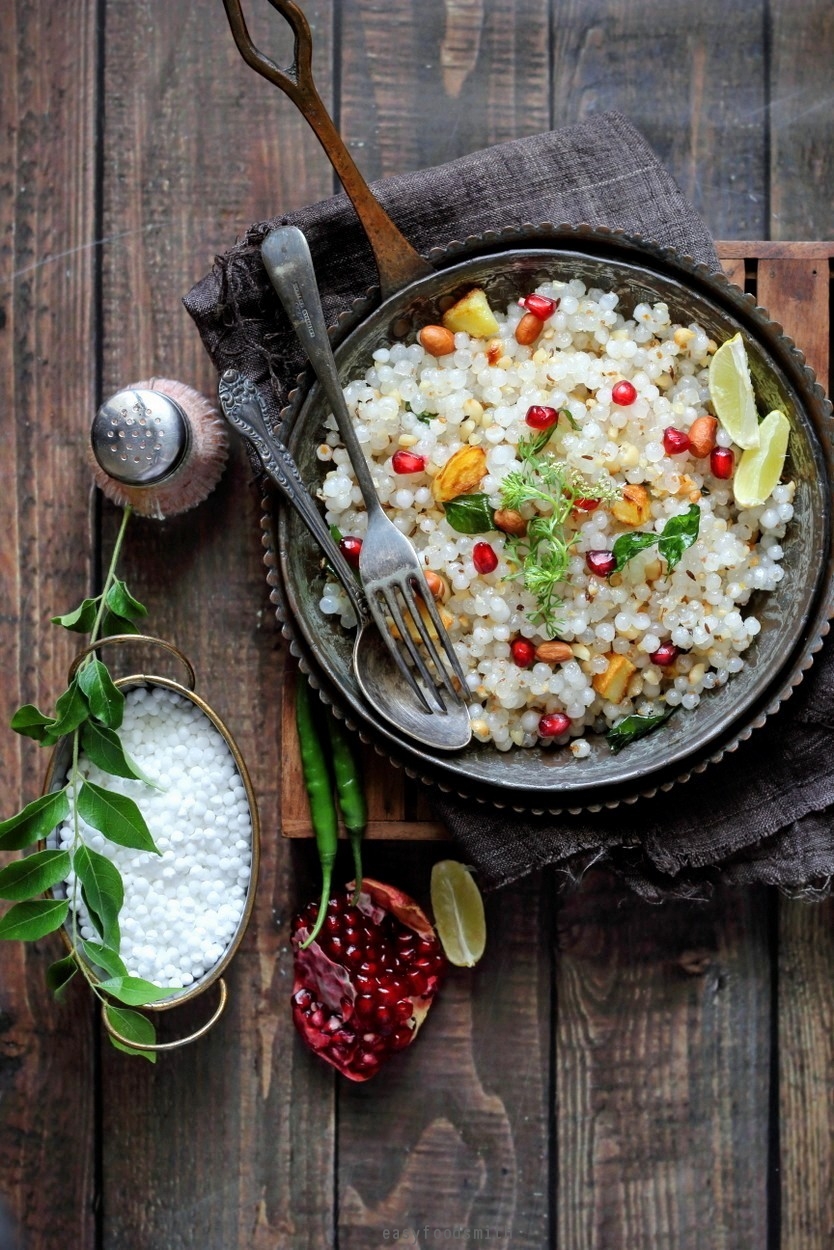
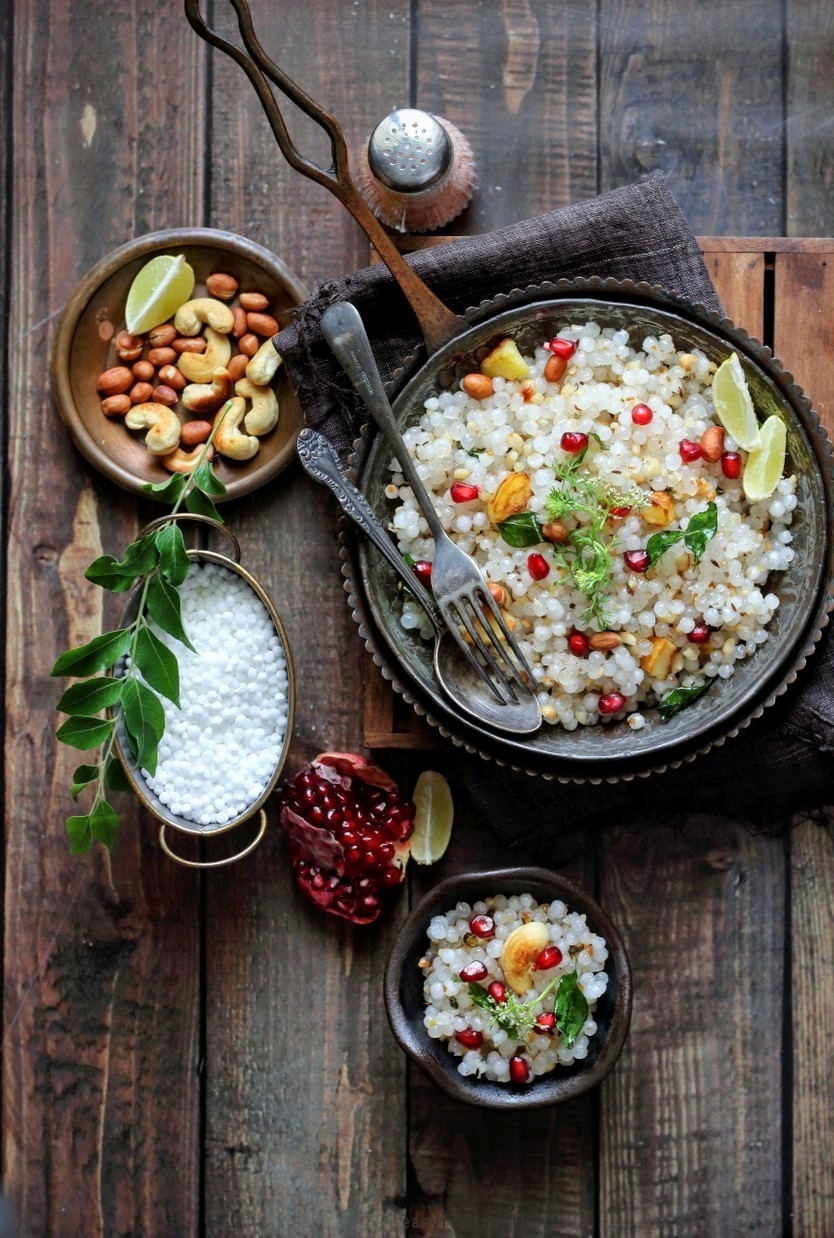
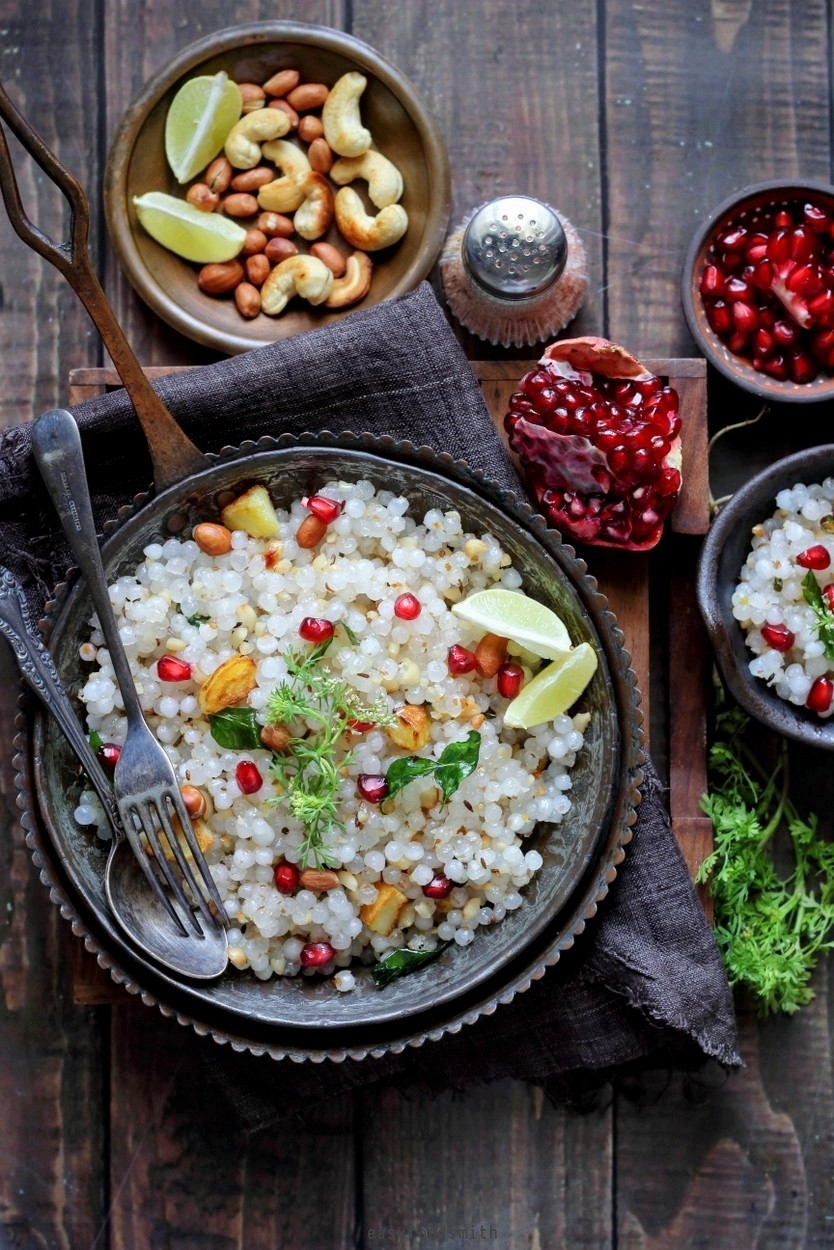
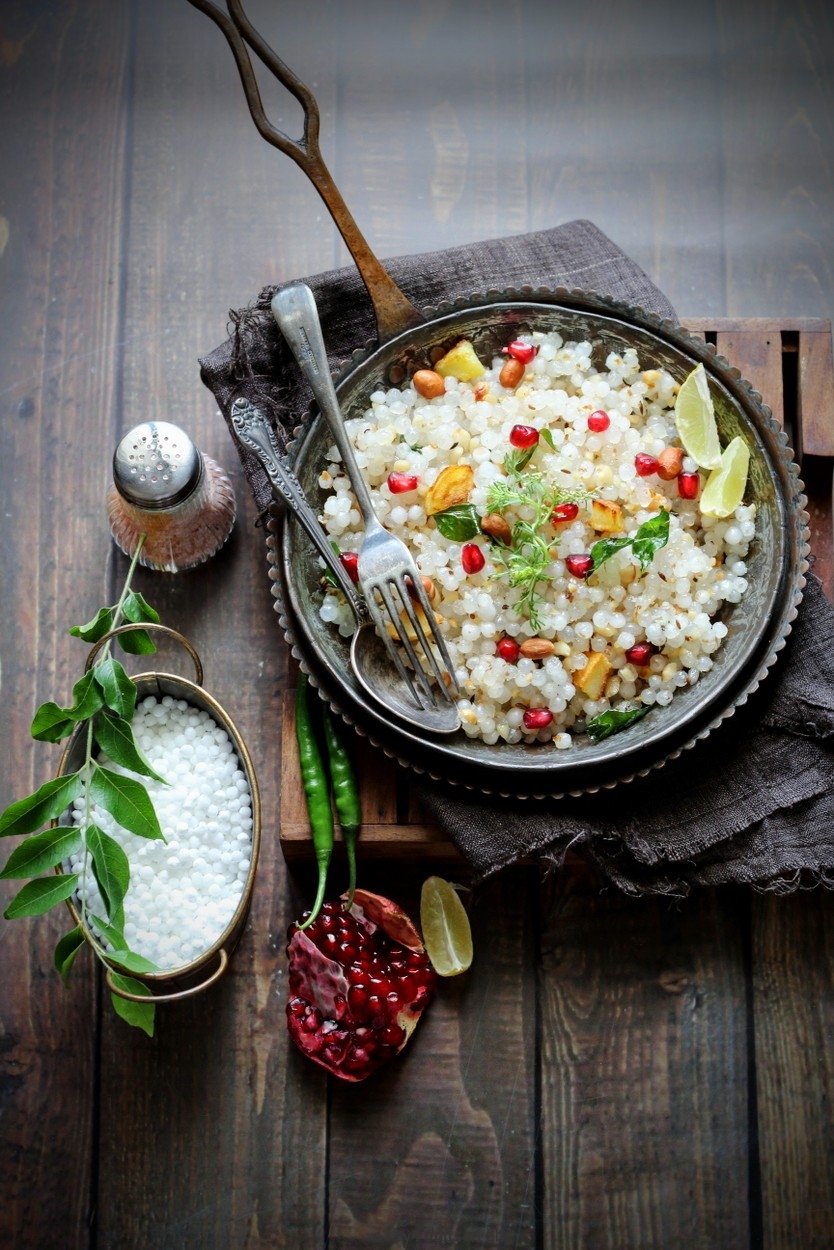
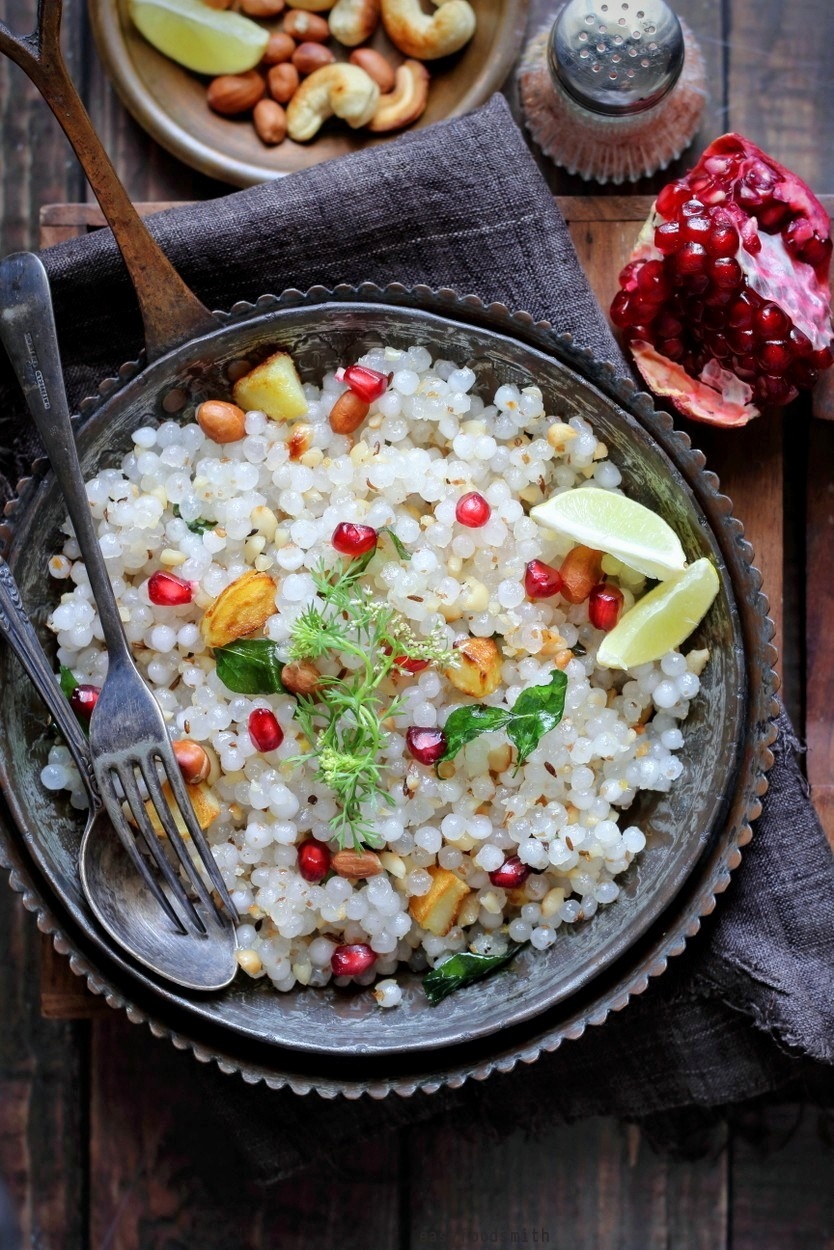
I have never had sago prepared this way…really interesting and I love how pretty it turned out.
Thank you Angie!
Another interesting and new porridge for me to try for my breakfast. Lovely! Thank you for this inspiration.
I hope you give it a go and enjoy it
I’m unfamiliar with sabudana, but I get the impression you could make this dish with tapioca pearls? Because there’s a shop near me that sells tapioca pearls, and I was just there the other day, looking at them, and wondering what I could do with them.
These are tapioca pearls! And you can turn into this savoury breakfast or make kheer / pudding from them. Both are delicious!
I love learning about the different regional dishes from various countries. I wasn’t familiar with this recipe, but it sounds delicious. I’m intrigued!
And Indian has so many regional dishes, it is mind boggling!
This looks beautiful! I’ve purchased a bag of sago pearls ages ago, but never knew what to make with it, so thanks for the inspiration
Thank you Evi! You can make this savoury porridge or make kheer with sago pearls. Its a creamy and delicious, gluten-free dessert 🙂
Wow what a really lovely dish this is – flavorful and so pretty!